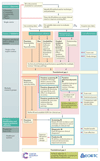Imaging biomarker roadmap for cancer studies
- PMID: 27725679
- PMCID: PMC5378302
- DOI: 10.1038/nrclinonc.2016.162
Imaging biomarker roadmap for cancer studies
Abstract
Imaging biomarkers (IBs) are integral to the routine management of patients with cancer. IBs used daily in oncology include clinical TNM stage, objective response and left ventricular ejection fraction. Other CT, MRI, PET and ultrasonography biomarkers are used extensively in cancer research and drug development. New IBs need to be established either as useful tools for testing research hypotheses in clinical trials and research studies, or as clinical decision-making tools for use in healthcare, by crossing 'translational gaps' through validation and qualification. Important differences exist between IBs and biospecimen-derived biomarkers and, therefore, the development of IBs requires a tailored 'roadmap'. Recognizing this need, Cancer Research UK (CRUK) and the European Organisation for Research and Treatment of Cancer (EORTC) assembled experts to review, debate and summarize the challenges of IB validation and qualification. This consensus group has produced 14 key recommendations for accelerating the clinical translation of IBs, which highlight the role of parallel (rather than sequential) tracks of technical (assay) validation, biological/clinical validation and assessment of cost-effectiveness; the need for IB standardization and accreditation systems; the need to continually revisit IB precision; an alternative framework for biological/clinical validation of IBs; and the essential requirements for multicentre studies to qualify IBs for clinical use.
Conflict of interest statement
J.P.B.O’C. (CRUK, Eli Lilly), H.J.W.L.A. (NIH), S.F.B. (AstraZeneca), R.B. (Philips), S.B. (CRUK), M.B. (CRUK, EPSRC), K.M.B. (CRUK, EPSRC, GE Healthcare), T.L.C. (NIH), S.C. (European Union FP7), G.J.C. (Alliance Medical, Bayer, Blue Earth Diagnostics, CRUK, GE Healthcare, Siemens Healthcare), N.M.dS. (CRUK, European Union FP7, NIHR), C.D. (CRUK), C.F-F. (AstraZeneca, Merck), F.A.G. (CRUK, GE, GSK), F.J.G. (CRUK, EPSRC), R.J.G. (NIH), V.G. (GE Healthcare, Siemens Healthcare), A.M.G. (GSK), A.L.H. (CRUK), D.J.H. (CRUK, EPSRC, Elekta, Philips, Truebeam), B.F.H. (GE Healthcare, Mediso, Siemens Healthcare), A.J. (CRUK, EPSRC), G.C.J. (AstraZeneca, Novartis, Oxigene, Roche), N.L. (Bracco), M.L. (CRUK, EPSRC), E.L.L. (GE Healthcare, Pfizer, Philips), J.S.L. (Eli Lilly, MabVAx Inc, NIH, The Curadel Companies), Y.L. (European Union FP7), T.N. (CRUK, EPSRC), A.R.P. (Acuitas Medical, Siemens Healthcare), G.J.M.P. (CRUK, EPSRC), M.P. (CRUK), A.C.P. (NIHR), R.A.S. (CRUK, HEFCE, MRC, Sirtex Technology), S.A.T. (NIHR), K.J.W. (Eli Lilly), P.W. (CRUK) and T.E.Y. (NIH) receive grants and financial support from the indicated sources. E.A. (Lightpoint Medical), H.J.W.L.A. (Genospace LLC), R.J.G. (HealthMyne Inc), T-Y.L. (GE Healthcare), K.A.M. (Imaging Endpoints), G.J.M.P. (GSK), R.A.S. (Affidea, BTG plc, Cancer Research Technology, Sirtex Medical, Vertex), D.C.S. (RSNA), S.A.T. (Robarts), M.vH. (Aquilab), P.W. (Astex Pharmaceuticals, Nextechinvest, Nuevolution) have acted as consultants for the indicated organizations. H.J.W.L.A. (Genospace LLC), J.L.E. (Merck & Co), R.J.G. (HealthMyne Inc), D.J.H. (IXICO PLC, visionRT), J.S.L. (pHLIP Inc), K.A.M. (Feedback PLC), G.J.M.P. (Bioxydyn Ltd), J.C.W. (Alderley Imaging Ltd, AstraZeneca), P.W. (Chroma Therapeutics, Nextechinvest, Piramed Pharma) hold stock and/or directorship from the indicated institutions. All other authors declare no competing interests. No authors declare relevant honoraria for speaking or patents.
Figures








Comment in
-
A new roadmap to improve translation of imaging biomarkers.Br J Cancer. 2016 Dec 6;115(12):1443-1444. doi: 10.1038/bjc.2016.374. Epub 2016 Nov 15. Br J Cancer. 2016. PMID: 27846201 Free PMC article. No abstract available.
-
Independent imaging biomarkers do not exist.Nat Rev Clin Oncol. 2017 Jul;14(7):452. doi: 10.1038/nrclinonc.2017.83. Epub 2017 Jun 13. Nat Rev Clin Oncol. 2017. PMID: 28607518 No abstract available.
References
-
- Biomarkers Definitions Working Group. Biomarkers and surrogate endpoints: preferred definitions and conceptual framework. Clin Pharmacol Ther. 2001;69:89–95. - PubMed
-
- Food and Drug Administration & National Institutes of Health. BEST (Biomarkers, Endpoints, and other tools) resource. NCBI; [accessed 4 February 2016]. http://www.ncbi.nlm.nih.gov/books/NBK326791. - PubMed
-
- Lesko LJ, Atkinson AJ., Jr Use of biomarkers and surrogate endpoints in drug development and regulatory decision making: criteria, validation, strategies. Annu Rev Pharmacol Toxicol. 2001;41:347–366. - PubMed
-
- Micheel C, Nass SJ, Omenn GS, Institute of Medicine Committee on the Review of Omics-Based Tests for Predicting Patient Outcomes in Clinical Trials . Evolution of translational omics: lessons learned and the path forward. National Academy of Sciences; 2012. - PubMed
-
- Workman P, et al. Minimally invasive pharmacokinetic and pharmacodynamic technologies in hypothesis-testing clinical trials of innovative therapies. J Natl Cancer Inst. 2006;98:580–598. - PubMed
Publication types
MeSH terms
Substances
Grants and funding
- R01 CA196701/CA/NCI NIH HHS/United States
- 16267/CRUK_/Cancer Research UK/United Kingdom
- MR/N020782/1/MRC_/Medical Research Council/United Kingdom
- 12011/CRUK_/Cancer Research UK/United Kingdom
- 16049/CRUK_/Cancer Research UK/United Kingdom
- 9993/CRUK_/Cancer Research UK/United Kingdom
- 16466/CRUK_/Cancer Research UK/United Kingdom
- 10345/CRUK_/Cancer Research UK/United Kingdom
- G0701533/MRC_/Medical Research Council/United Kingdom
- MR/J007986/1/MRC_/Medical Research Council/United Kingdom
- 10348/CRUK_/Cancer Research UK/United Kingdom
- 17242/CRUK_/Cancer Research UK/United Kingdom
- EME/13/122/01/DH_/Department of Health/United Kingdom
- 11566/CRUK_/Cancer Research UK/United Kingdom
- 21993/CRUK_/Cancer Research UK/United Kingdom
- 16584/CRUK_/Cancer Research UK/United Kingdom
- NIHR/CS/009/009/DH_/Department of Health/United Kingdom
- G0700915/MRC_/Medical Research Council/United Kingdom
- 22897/CRUK_/Cancer Research UK/United Kingdom
- 8971/CRUK_/Cancer Research UK/United Kingdom
- 11359/CRUK_/Cancer Research UK/United Kingdom
- 22746/CRUK_/Cancer Research UK/United Kingdom
- 10337/CRUK_/Cancer Research UK/United Kingdom
- 19908/CRUK_/Cancer Research UK/United Kingdom
- G0300648/MRC_/Medical Research Council/United Kingdom
- NIHR-RP-02-12-019/DH_/Department of Health/United Kingdom
- 18097/CRUK_/Cancer Research UK/United Kingdom
- 15267/CRUK_/Cancer Research UK/United Kingdom
- U01 CA143062/CA/NCI NIH HHS/United States
- P30 CA008748/CA/NCI NIH HHS/United States
- 18974/CRUK_/Cancer Research UK/United Kingdom
- 20000/CRUK_/Cancer Research UK/United Kingdom
- 19278/CRUK_/Cancer Research UK/United Kingdom
- MC_UP_1302/4/MRC_/Medical Research Council/United Kingdom
- 16463/CRUK_/Cancer Research UK/United Kingdom
- 11562/CRUK_/Cancer Research UK/United Kingdom
- 16628/CRUK_/Cancer Research UK/United Kingdom
- 16464/CRUK_/Cancer Research UK/United Kingdom
- 10342/CRUK_/Cancer Research UK/United Kingdom
- 16465/CRUK_/Cancer Research UK/United Kingdom

